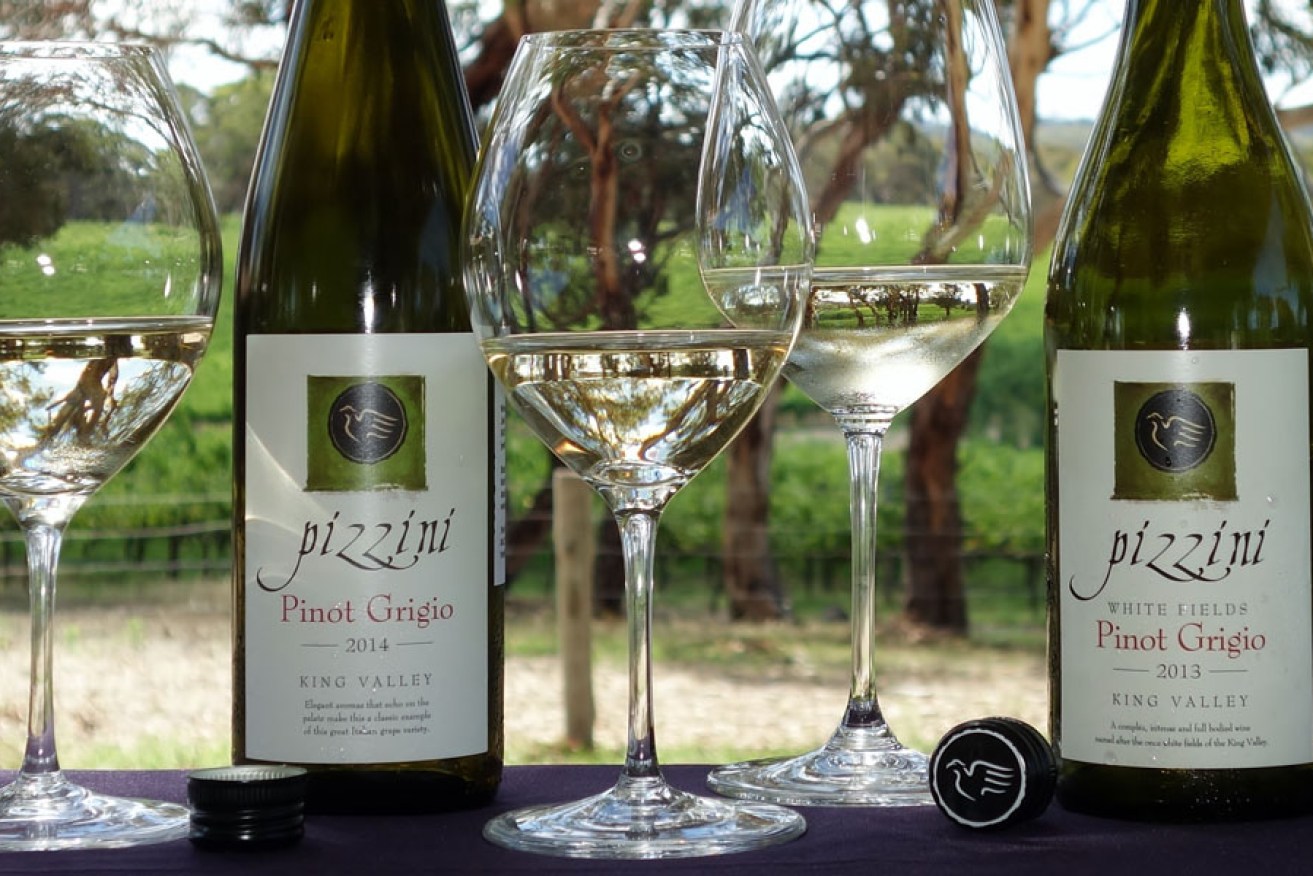Whitey has discovered two versions of Pinot Grigio which tickle his fussy fancy. They’re from the north side of the Victorian Alps, and are made by a family of hearty gastronomes from alpine Italy.
Pizzini King Valley Pinot Grigio 2014
$21; 12.1% alcohol; screw cap; 91++ points
If there was a face-creamy zabaglione thing made with Passe-Crassagne pear cider and some juniper, it’d smell like this. But it wouldn’t taste much like this.
This is no frothy frivolity. This is a tight stonewall of a drink, as austere and set as the great carved faces of Easter Island. Once you get a proper lick of it, you can feel it gazing you down, unblinking. Its acidity is stern and solid; its fruit just enough to make that architecture drinkable.
It’s a balancing act: tease sensually with the fragrance; change gears with the adults-only mouthful. So what happens? You’re left lurching this way and that, starving, spinning out, waiting for a chair and somebody to hand you a menu. Which means to me that it succeeds beautifully.
Order garfish whole from the char grill, with black pepper and chilli. And while they prepare that, you’ll notice the wine level descends very quickly to about half way down the label. Where’d that go? Into you, my friend. If it’s completely empty, I’ll simply hope you have company. If you don’t, I understand. Stay nice.
If you chill this wine, the contrast between its bouquet and the taste closes right up, and that yin-yang seesaw diminishes as the whole thing homogenises. So I much prefer it at cellar temperature, with maybe just a flash of ice bucket: it’s more provocative.
Pizzini White Fields King Valley Pinot Grigio 2013
$27; 12% alcohol; screw cap; 92+ points
Named after the native clover that burst out when the 1870s settlers cleared the King Valley for farming, this is winemaker Joel Pizzini’s serious grigio.
Still stonkered by the austere vivacity of the standard model, the reviewer holds off to consult the typically literary Pizzini PR sheet, bewildered to read Joel saying: “Unlike our easy-drinking Pizzini Pinot Grigio [!], the White Fields is restrained … ”
Sweet Jesus. It certainly smells less frivolous than the cute bouquet of the previous beauty, with more autumnal mellow fruits, like hessian bags of pears softening in the barn, that hempy sack aroma tickling the nostrils while the ageing pears settle things down. More yin and yang. The palate is much richer and more complex, like somebody made a pickle of those pears with some figs and ginger, pepper and mace. But it’s smooth, and calming. (Time out to consult my new jar of Marian Harvey’s soulful Bremer Valley Fig & Ginger conserve … right on the money!)
The wine has cosy flesh, and its grainy tannins set me wishing I had a chunk of Grana Padano Po Valley cheese to dip in Marian’s conserve. Some Margaret River Dairy Club Cheddar is all I have to hand, and that sure works.
But back to Joel’s notes: “The palate is lingering and cries out for potato gnocchi with creamy gorgonzola cheese sauce and a dusting of nutmeg.” Revering chef Katrina Pizzini’s wisdom in marriages of the family’s wine with her take on traditional alpine Trentino Alto Adige cuisine, I’ll just pop that notion in your savouring division. It does sound wicked.
Don’t chill this wine too hard. True cellar cool (12-15 C) is enough.
While the 2014 wine has been made more like, say, the Clare and Eden folks make their Riesling, in steel, with carefully selected yeasts, the White Fields is a more sophisticated piece of work. Granted, while the ’14 was carefully constructed from four vineyards on different sites, all picked at different stages to add complexity and form, the White Fields is from the oldest Pinot Grigio vines in the suite, whole bunch-pressed, then divided for ferment into two parcels. Half goes into old French barrels and left to the wiles of indigenous yeasts, the other goes into steel, and selected cultured yeasts are consecutively added to perform specific tasks after the wild local yeasts have had their munch at it.
Both parcels are left on the lees for five months, and stirred fortnightly. A small amount of Whitlands fruit is added to supply some tighter acidity. At 800 metres, that alpine site is 540 metres higher than the Pizzini vineyards, and so is much more austere, steely and crunchy.
Think of grigio’s history, and its nature. It’s a grey-skinned – grigio, gris – offshoot of Pinot Noir. The steel tank model, the ’14, is more along the lines of the Pinot Noir of Champagne, while the White Fields ’13 is closer in form and mood to the Pinot Noir of Burgundy, which is warmer. But both these wines are white.
They are exemplary versions of this much-abused and misunderstood variety. Put simply, you shouldn’t bother growing the grigio or gris anywhere you can’t grow the noir parent properly. Which means cool to cold sites, and precludes most of the stuff that comes from the hot irrigated grapeyards of the Murray-Darling. Which is where most of Australia’s grey Pinot grows.







